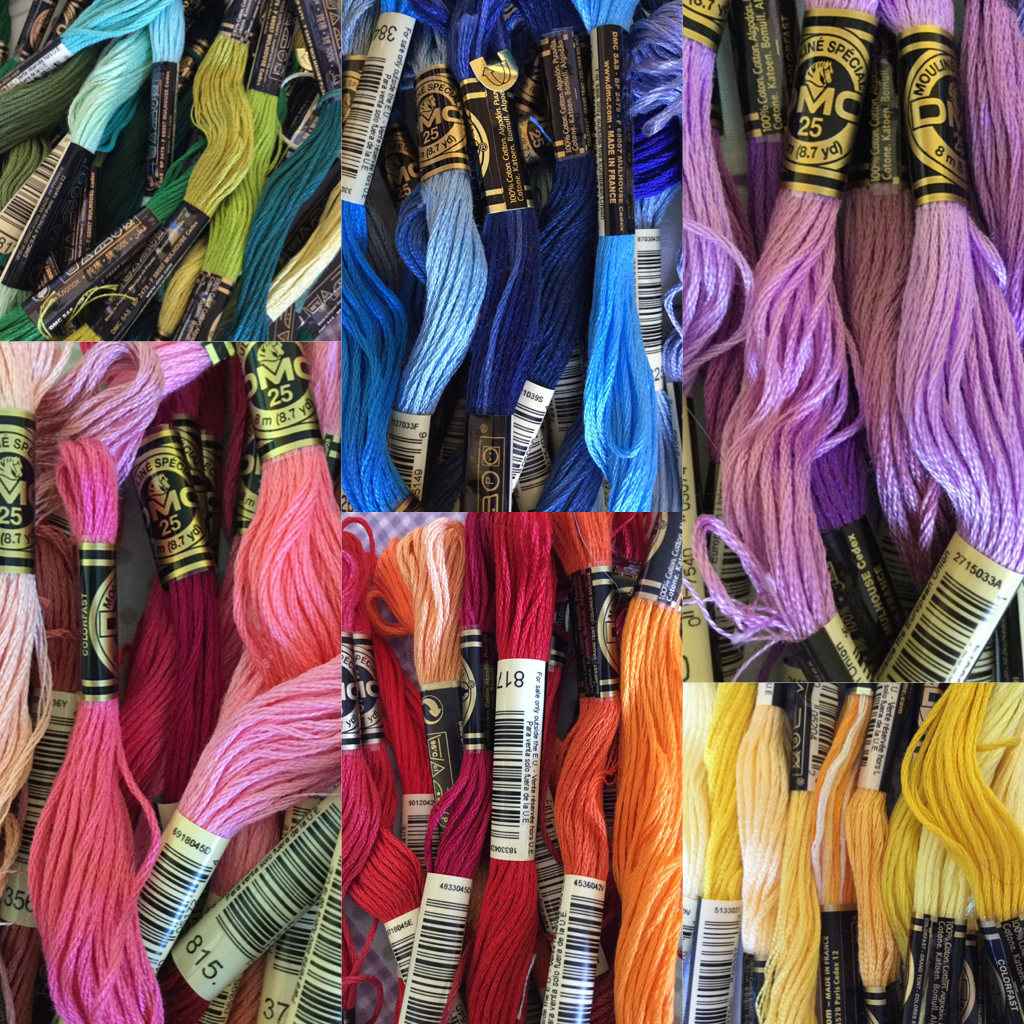10 Things I Learned by Being Bad at Cross Stitch
I sometimes cringe when I think about the mistakes I made when I first took up cross stitch as a serious hobby. But you know what? I’m not embarrassed to lay bare all of my errors because I know now that it’s all part of the learning process. Do you find any of these relatable?
1: Read the instructions
This may seem obvious but when I started my first big project I didn’t read all of the instructions before I began stitching. This led to some very basic errors that made my stitching experience much more frustrating (and expensive!) than it should have been.
I didn’t know you were supposed to separate the six strands of floss so I was using the whole lot for every stitch. You can imagine how long it took me to thread the needle EVERY TIME. It also made it really hard to get nice neat stitches. Not to mention the fact that I had to keep buying more floss.
My first attempt at a large cross stitch kit didn’t go well
Needless to say I only made this mistake once but it’s always worth spending a few minutes looking at the instructions, even if you’re a know-it-all smarty-pants like teenage me. The key will tell you how many strands of floss you need to use for each colour and what type of stitch to use.
And while it isn’t essential, familiarising yourself with the symbols can help you see at a glance where each colour will be used on the pattern. Comparing the chart with the reference photo will also help with this.
2: Understand how skeins of floss work
Following on from my epic fail described above, did you know that there’s a right and wrong end to pull your floss from? DMC skeins should be started from the end that has the floss number on it, not the branded end. Find the end and gently pull it out.
When you cut a length of floss, you don’t want it to be too long or too short. I always hold the end in my fingers and snip off the thread just below my elbow. I find this is the perfect length for me to work with but you can adjust this with trial and error of you need to.
Embroidery floss is made up of six strands and cross stitch is usually worked in two strands. The easiest way to separate the strands is to peel them off one at a time, but if I’m honest I usually don’t have the patience for that and I usually do it in pairs. This sometimes means the floss becomes slightly twisted, which is why you’re supposed to do it one at a time.
3: Count carefully
Cross stitch is not a hobby for impatient people; there’s a lot of counting involved. It’s important to get this right, otherwise you can end up with a slightly wonky design. The best place to start is from the middle of your fabric to ensure your design id roughly centred.
Follow the arrows on the chart to find the centre of the pattern; this will tell you which colour to start stitching with. Your counting is extra important at this crucial stage as a mistake here could throw the whole design off. I always count twice in these early stages to make sure everything is in the right place. After that it should get easier but don’t rush it.
Having said that, small counting areas can often be easily worked around but it’s better to catch them sooner rather than later.
4: Take Breaks
Spending hours sitting in one spot staring at the chart and fabric is going to put strain on your eyes, neck and back. You’ll feel a real benefit from taking regular breaks. To rest your eyes, look at something on the other side of the room or out of the window. If your neck and back feel tight do some gentle stretching. There are plenty of videos on YouTube that can teach you how to correct your posture and relieve pain and tightness. I recommend Ask Doctor Jo.
It also helps to give your brain a rest and to think about something other than cross stitch symbols and cutting floss. Ironically, I find that stitching is more enjoyable when I haven’t become completely consumed by the project.
Stitching until you’re too tired to carry on means you’re more likely to make mistakes and you’re less likely to catch them. You’ll come back to your project the next day feeling fresh and ready to go, only to find that you have to unpick a whole section. I’ve learned from bitter experience that it’s better to stop before you get to that point.
5: Use a hoop or frame
This is a matter of personal preference and some people prefer not to use either a hoop or a frame but I find it makes my stitching experience easier and more practical. I find my stitches are neater when the fabric is being held taut, and my posture is better when I’m using a hoop.
Hoops come in different sizes so be sure to get one that’s right for your project. For example, if your design is approximately 3”x 3” (8x8cm), make sure you cut enough fabric to fit into a 6-inch (15cm) hoop. This will give you some leeway if your design isn’t quite centred. You then have the option to frame your project in something smaller.
If you’re working on a larger project, use a hoop that allows you work on a decent amount of it at any one time. It’s best to remove the hoop when you finish stitching for the day to allow the fabric to relax. Also, take care not to tighten the hoop too much as you may crush your stitches. Alternatively you can use a frame that can be rested on your knee or a desk. Very large projects can be attached to a standing frame.
6: Keep your hands clean
Again, this may seem obvious but it’s easy to get into bad habits. If like me you enjoy snacking on a bit of chocolate in the evening, don’t do it while stitching. I have a couple of projects from my childhood/teenage years in my stash that have smudged chocolatey finger prints on them. It also goes without saying that you need to be careful where you place your drinks; one accidental nudge could spell disaster! You may want to keep wet wipes or tissues to hand, just in case.
7: Choose a project that’s right for you
While I was at university I spent numerous evenings stitching a design of St Paul’s cathedral. It looked really impressive when it was finally done but I got very bored while working on one shade of grey after another.
When you’re choosing a project, make sure it’s something that will hold your interest all the way through, otherwise it’s probably going to end up at the bottom of your WIPs drawer never to be seen again. It’s one thing to challenge yourself but hobbies are meant to be enjoyable, so choose a design that will inspire your creative side every time you pick it up.
If you’re a complete beginner, start small. Try kits in different styles to find out what you like best. My bird kits are a perfect place to start.
8: Keep track of your stash
Organising your stash by colour can make your life easier
If you like stitching as much as I do and you’ve been doing it for several decades, you’ve probably built up an impressive stash of floss in a huge variety of colours. It’s important to know what you’ve got in stock for a number of reasons.
Good quality floss isn’t cheap, so you don’t want to waste your money by accidentally buying duplicates. Conversely, you need to know if you don’t have enough of any particular colour to finish your project. It would be really annoying if you have to make more than one trip to the craft shop or place another online order because you underestimated how much you have in stock.
I organise my stash by colour and this makes it easier for me to see what I have and what I need. I also use a spreadsheet to keep track of what I have as my stash is way too big to track it by memory.
If you sign up to my newsletter you can download a free Floss Stash Tracker to help you organise your skeins.
9: Swap the fabric if you don’t like what’s in your kit
This follows on from earlier points I made about keeping your motivation for the duration of your project. Returning once more to barn owl project, the original kit included a beige/brown aida that I found very uninspiring. When I restitched the design, I chose a blue Evenweave that I like so much more.
10: Make the chart easier to read
After you’ve spent a while staring at a grid full of black and white symbols, you may find that they start to look the same. This is a cue to take a break but there are some things you can do to make your chart easier to work with.
When I’m working from a black and white chart I like to use highlighters or coloured pencils to block out symbols so my eyes don’t have to strain to read the actual symbol all the time. I find this speeds up my stitching.
If you feel the chart is too small you can enlarge it on a photocopier. If you’re not sure how to do this, your local library may be able to help.
You can also adjust the size before you print it.
If the chart is in several sections you could stick them together with clear tape or pin them together on a cork board. This will save you from the chaos of having several pieces of paper which can be easily mislaid.
I hope you’ve found this article helpful and I hope you can see that you can be really bad at something when you first take it up and become so much better by learning from your mistakes as you stick with it. Cross stitch has had a hugely positive impact on my life and I’m excited to share this fun and creative hobby with you!


